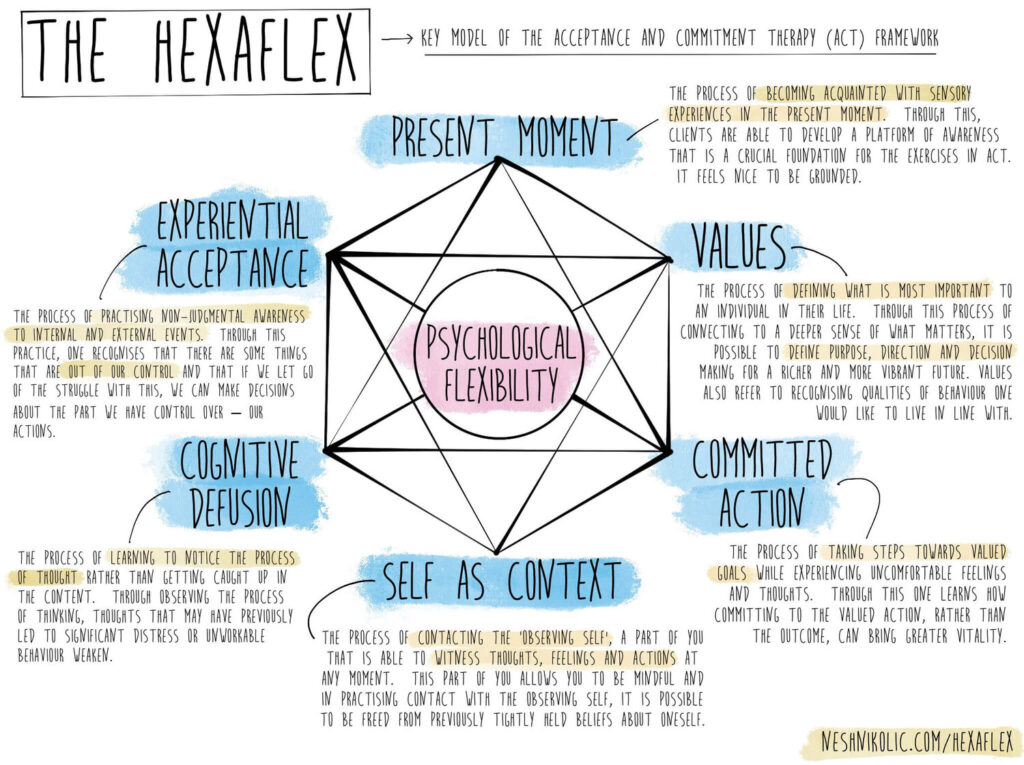Disclaimer: My content is NOT a substitute for professional advice, diagnosis, or treatment. When in doubt, ask a therapist!
For many, cognitive behavioral therapy (CBT) is the gold standard of psychotherapy. But it might not be suitable for everyone.
A meta-analysis found that the remission rate of CBT clients with anxiety (which includes social anxiety, PTSD and GAD) is only 51%.
If you tried CBT and it didn’t work for you, here’s another therapy method that you could consider:
Acceptance and commitment therapy (ACT).
Developed by Steven C. Hayes, acceptance and commitment therapy (ACT) is a popular therapy method that’s been validated by over 1,000 studies.
But how is it different from CBT? The names give away the answer, as you will see in a second…
What is ACT? How is it different from CBT?
CBT, cognitive behavioral therapy, focuses on cognition and behavior: identifying thought and behavioral patterns that lead to anxiety.
ACT, acceptance and commitment therapy, focuses on compassion: accepting your thoughts and emotions, then taking action in alignment with your values. Put it another way…
Rather than eliminating or reducing emotional difficulties like CBT does, ACT’s goal is to help clients develop psychological flexibility, so that they can live their lives in the face of challenges.

Credit: Nesh Nicholic
All this being said, the distinctions are increasingly blurred, as CBT has been incorporating elements of ACT.
Examples: Mindfulness-Based Cognitive Therapy (MBCT) and Compassion-focused therapy (CFT). (Steven C. Hayes himself wrote a book on process-based CBT!)
Does ACT work for social anxiety?
A review of 11 studies shows that ACT is effective for social anxiety. While the researchers didn’t find a huge difference between ACT and CBT’s impact, the latter can be slightly more effective, according to Larry A. Cohen, the co-founder of the National Social Anxiety Center (NSAC).
Now, here’s what fascinates me… the researchers suggested that ACT and CBT can complement each other. In their words:
“ACT could be used to increase attention to mental acceptance and flexibility, which in turn leads to improved self-perception of symptoms. Instead, traditional CBT has the task of promoting behavioral exposure and of inducing cognitive processes during the interaction with the therapist.”
ACT techniques to help you manage social anxiety
I’m grateful to have learned ACT from top therapists like Steven C. Hayes and Russ Harris, and here are my favorite techniques:
Drop an anchor
How this helps: staying present
It’s far too easy to get pulled away by the currents of your emotions.
To prevent that from happening, you “drop an anchor” by:
- Returning to your body (your physical senses)
- Recognizing your thoughts and emotions
- Re-engage in whatever you are doing with a deeper/broader awareness
For other mindfulness exercises, check out my article here.
Wrap the ping pong ball
How this helps: accepting your anxiety
First, find a ping pong ball. If you don’t have one, paper — in the form of a ball — would do.
Imagine that your social anxiety is the ping pong ball that you’re holding in your hand.
Each time you try to avoid or eliminate your anxiety, you wrap a piece of paper around the ball.
After this happens a number of times, does the ball — representing your anxiety — become bigger? You bet!
The point of this exercise is to demonstrate how our anxiety worsens as we fight it. Russ Harris explains why that’s the case in this entertaining video:
A wider view
How this helps you: accepting your anxiety
Imagine that your family member, friend, or loved one is going through the same experience as you.
- How would you feel?
- What would you say to them?
- What would you suggest they do?
When it’s hard to be kind to yourself, changing perspectives can help. Also, here’s a list of questions to help you further cultivate kindness.
Say yes
How this helps: accepting your anxiety, and taking action despite anxiety
Here’s how you apply it in your life. When you feel a difficult emotion or sensation, you say to yourself…
“yes that’s OK, that is just like that; it does not have to change; I can just allow that to be just as it is”
By doing so, you’re not tolerating your experience — nor do you have to force acceptance — you’re simply acknowledging it and allowing it to be part of your life.
You can also say yes to things or people that make you socially anxious. For example, if talking to a barista feels scary, say yes and approach her anyway, rather than avoiding the conversation.
For more details about this exercise, check out Steven’s PDF.
Related articles

